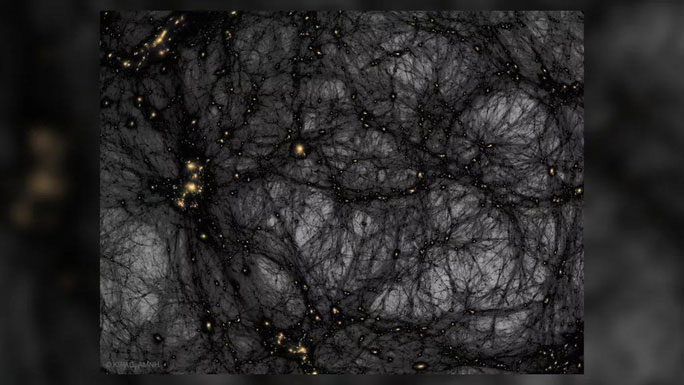Cosmic relics from another dimension may very well be the elusive “ghost particles” that constitute what scientists around the globe are pursuing as “dark matter.”
A collaborative study between the University of Lyon (France) and a South Korean university has pieced together many mysterious fragments and identified the most plausible origin of the enigma known as “dark matter.”
Dark matter is invisible, yet scientists worldwide have found substantial evidence of its presence, typically through its interactions with observable matter. It is believed that dark matter constitutes a significant portion of the universe’s mass.
Our planet Earth is thought to be situated within a storm of dark matter, with its invisible and harmless “ghost particles” swirling around us in the surrounding space.

This graphic, enhanced by the Dark Universe Program at the Hayden Planetarium, American Museum of Natural History, illustrates how dark matter exists around us as mysterious black strands, enveloping everything in space. (Image: Tom Abel & Ralf Kaehler (KIPAC, SLAC), AMNH)
A research excerpt published in Live Science states that these “ghost particles” from dark matter were initially thought to be massive particles known as gravitons, which emerged in the first moments following the Big Bang, created by collisions of ordinary particles.
However, in research published in Physical Review Letters, physicist Giacomo Cacciapalia from the University of Lyon (France), the lead author, explained that if gravitons possess such characteristics, they would be exceedingly rare and unable to form the abundant dark matter filling the universe.
This new study posits that gravitons must have a mass of less than 1 megaelectronvolt (MeV), significantly lower than the particles that make up ordinary matter. For comparison, a proton weighs about 940 MeV.
According to Science Alert, the research team also discovered hypothetical attractions while searching for evidence of extra dimensions – that is, other spatial dimensions – which some physicists suspect exist parallel to the observable three-dimensional space and time, regarded as the fourth dimension.
The team’s new theory suggests that as gravity transmits through these spatial dimensions, it manifests our universe in the form of large gravitational particles. These particles would interact weakly with ordinary matter and thus be extremely difficult to detect.
Thanks to their weak interactions, the particles that make up dark matter decay so slowly that they remain stable throughout the universe’s existence.
The research team believes that particle accelerators, such as the Future Circular Collider at the European Organization for Nuclear Research (CERN) – scheduled to begin operations in 2035 – will be powerful enough to search for direct evidence of these ghost particles.

















































